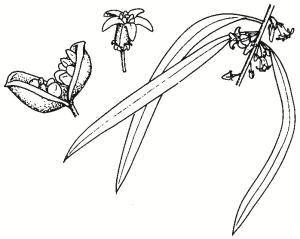Family:
Pittosporaceae
Pittosporum angustifolium
Butterbush
(syn. P. phyllireaoides)
Other Names: Weeping Pittosporum, Berrigan, Native Willow, Native Apricot, Western Pittosporum.
First Nations Name(s):

Name Origin:
Pittosporum – from Greek pitte, to pitch, and sporos, seed, referring to seed covered by dark sticky substance in many Pittosporums.
Regional Subspecies:
Occurrence:
Regional:
West of the Olympic Highway, usually in isolated clumps. Probably previously more common.
Australia:
Mainland states and territories.
Habitat:
Woodland and mallee, and widespread on sandy soils in the arid zone.
Habit:
Shrub or small tree to 10 m high. Virtually hairless with drooping branches, whitish or mottled trunk, narrow leaves 4-12 cm long and characteristic orange fruit.
Site Preference:
Tolerates drought and frost. Prefers full sun. Resents waterlogging.
Characteristics:
Very hardy. Slow-growing but long-lived. Highly palatable to stock.
Flowering:
Yellow to cream, winter-spring. Fragrant.
Seed Collection:
Early Dec to late May.
Propagation:
From fresh seed (± 50 viable seeds per gram) or cuttings. Remove germination inhibitor from sticky seed by washing seed in detergent and rubbing with dry sand for several minutes before sowing. Germinates in 2-3 months.
Regeneration:
Suckers readily.
VALUES:
Shade & Shelter:
Useful low-level cover in windbreaks.
Land Protection:
Useful for stabilising banks.
Wildlife:
Good habitat. Sticky seeds eaten by birds.
Timber:
Timber close-grained, light-coloured and very hard. Turned into small articles such as tool handles.
First Nations:
Uses varied with location. Some clans ate gum from wounded branches. Others pounded seed into edible flour. An infusion was prepared from leaves, seed or wood to relieve internal pain and cramp, and treat colds, sprains, eczema and itching.
Ornamental:
Very decorative ornamental for parks and gardens. Graceful weeping habit and attractive orange fruit.
Other:
Cut for fair emergency fodder during drought.
